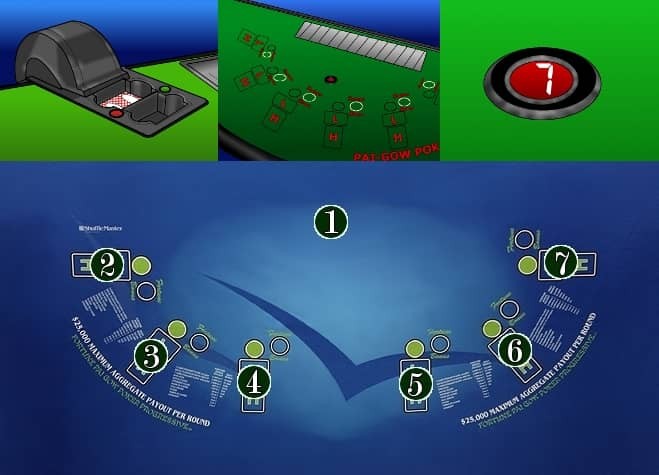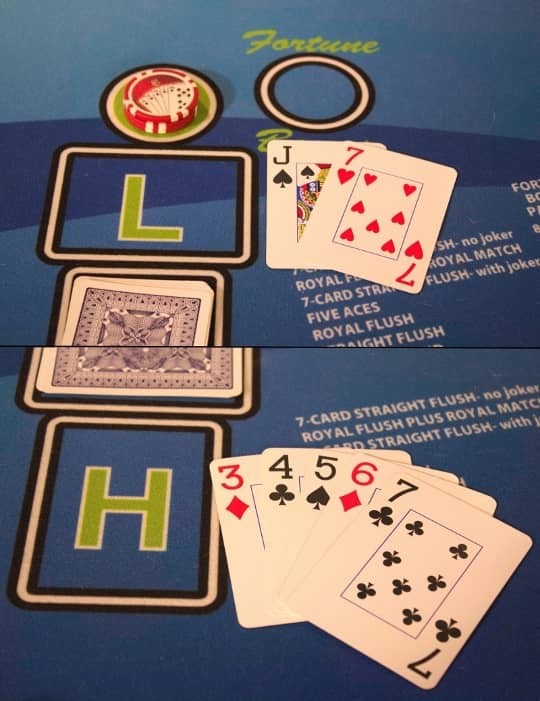The Basics & Setting the Player’s Hand
How to Play Pai Gow Poker: Part 1
Table of Contents
- Brief History
- The Basics
- The Joker Card
- The House Edge
- The Object of the Game
- How to Start Playing Pai-Gow Poker
- Setting Up the Player's Hand
How to Play Pai Gow PokerFurther Reading
- Part 1: The Basics & Setting the Player’s Hand
- Part 2: Foul, Folding, Setting the Dealer’s Hand & Determining a Winner
- Part 3: Poker Hand Rankings
- Part 4: Commission & Playing as Banker
- Part 5: The Dragon Hand, Fortune Bonus & Envy Bonus
- Part 6: The House Way
- Part 7: How to Play at Home
Did this free course help you?
Click to leave a tip to help keep this resource free!
Brief History
Pai-Gow Poker is a variation of Pai-Gow tiles,using a 53 card deck in place of the domino looking tiles. It was invented in 1985 by Sam Torosian, who received some bad legal advice and never patented his game. Because of that, there was nothing he could do when competitors started using his game without paying him a single cent, a mistake which cost him hundreds of thousands of dollars.
The Basics

Now, on to the table layout. It may look confusing at first, but it is really quite simple.
-
The bank is located in front of the dealer and this rack is where all of the house’s cheques are situated.
-
In front of the bank is where the dealer arranges their cards.
-
The discard rack is where all of the unused cards are placed.
-
The round betting circle is where you place your main bet and the fortune bonus bet can be found to the right of that.
-
The horizontal shaped rectangle with the L in the center is where the player places their 2 card Low Hand.
-
The vertical shaped rectangle with the H in the center is where the players place their 5 card High Hand. This game can have up to 6 players at a time.
The Joker Card

Like I said before, the dealer will use a deck consisting of 53 cards. No, that wasn’t a mistake. The dealer will use a normal 52 card deck with a Joker added to the mix. The Joker card acts as a wild card and can be used to complete any kind of straight or flush. When the Joker is used to complete a flush, it will represent the highest value card that is not already held in that hand. If the Joker card cannot complete any straights or flushes then it turns into an ace. Because this game follows the basic poker concept, it has the same poker hand rankings as normal poker with the only exception being that, in some casinos, the second highest straight is an Ace, 2, 3, 4, 5.
The House Edge
The house edge in Pai-Gow Poker depends on whether you’re banking or not. When you are banking and you play by the house way, you’re essentially playing with no house edge. However, when you’re not banking, the house edge is about 2.9%. If the house allows co-banking, then the house edge comes out to about 1.4%.
The Object of the Game
When playing Pai-Gow Poker, the object of the game is to form two winning poker hands from the seven cards that were dealt. In order to win their wager, the player must win both of their hands against the dealer. If they win, they’ll get paid 1:1 but they’ll have to pay a 5% commission. If the player loses both of their hands, then they lose the wager. If the player wins one hand and loses one hand, then it is a push and no money is exchanged. The player is only playing against the dealer, who is acting as the banker, and is not playing against the other players.
There is one exception to this rule and it is explained in the “Player/Banker” section.
How to Start Playing Pai-Gow Poker
To start off this game, the player will determine how much they want to bet. If the player is on a Fortune Pai-Gow table, then they have the option of making a side bet. Once the cards have been dealt out, the player cannot change their bet.
Once all of the players have finished making their bets, the dealer will hit a button on their shuffle machine and the machine will spit out a pile of 7 cards. At the same time, the random number generator, located in the middle of the table, will display a number that will help the dealer determine which spot will get the first set of cards.

Each seat is assigned a number starting from 1 and ending with 7. The banker will always start as 1, and then the counting will continue counter clock-wise to determine the remaining numbers. Each spot is dealt a hand regardless of how many players are at the table. Once all of the cards have been distributed, the players are now allowed to look at their hands.
Setting Up the Player's Hand

Out of the 7 cards that the player receives, they will need to arrange 2 separate poker hands by determining their best 5-card hand and their 2nd best 2-card hand. The 5-card hand is also known as your “High Hand” or “Back Hand”, since these 5 cards will contain your highest ranking hand, such as a straight, two pair and so on.
The 2-card hand is also known as your “Low Hand” or “Front Hand”, since these 2 cards will contain your 2nd highest ranking hand, such as a jack, 7 or a pair of nine’s.
